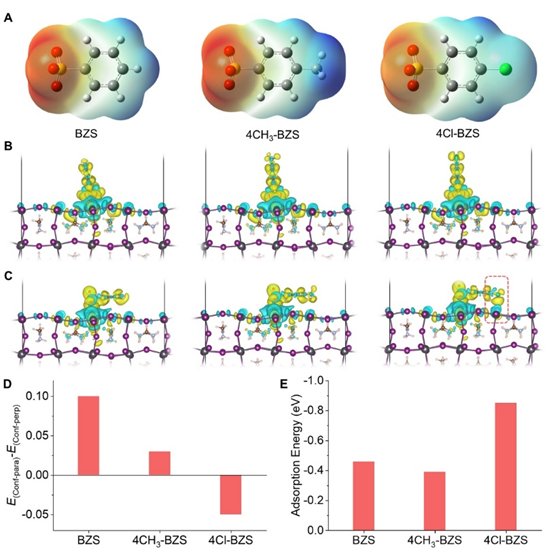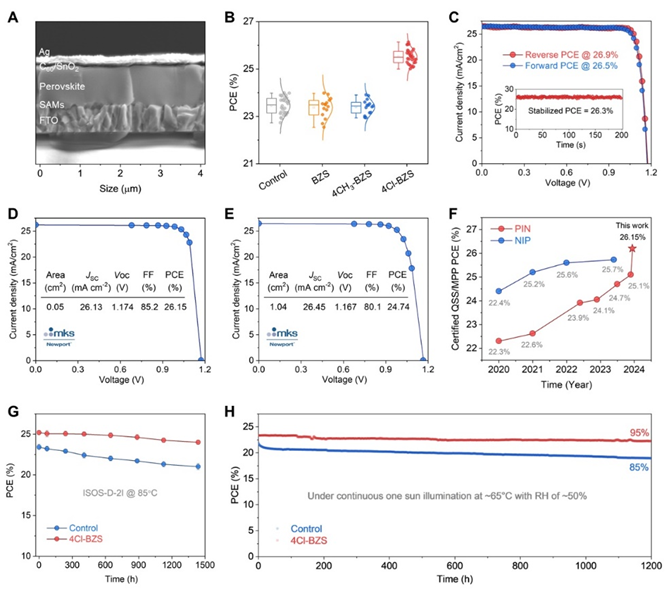Halide perovskite solar cells are currently deemed as the most promising third-generation photovoltaic technology, opening vast opportunities for transformative development in the solar cell industry. In recent years, the efficiency of halide perovskite cells has been constantly improved, however, there remains a gap compared to the theoretical limits. Therefore, enhancing the efficiency of perovskite solar cells has captured the focus of both industry and academia.
Owing to the inherent tendency of perovskite ionic crystals to dissociate and form defects on the surface thereof, molecular passivation on the perovskite surface is a critical approach to prevent defect formation, thereby enhancing device performance. However, the organic passivation molecules currently in use typically bind only to individual active sites on the perovskite surface, resulting in weak binding energy. Additionally, these single-site passivation molecules may densely stack vertically on the perovskite surface, likely introducing transport barriers at the perovskite/electron transport layer interface and adversely affecting charge extraction.
On April 12, a team led by Associate Professor Ning Zhijun in the School of Physical Science and Technology at ShanghaiTech University, together with the Sargent team in Northwestern University in the United States, achieved a breakthrough in perovskite photovoltaic device efficiency. This advancement was obtained by the precise regulation of the arrangement of organic passivation molecules on the surface of perovskite, and the results were published online in an article titled “Improved charge extraction in inverted perovskite solar cells with dual-site-binding ligands” in Science. This research utilized 4-chlorobenzenesulfonic acid sodium (4Cl-BZS) as the passivation molecule with dual binding sites. 4Cl-BZS interacts with adjacent lead ions on the perovskite surface through its chlorine atom and sulfonic acid group, thereby enhancing the binding energy between the molecule and the perovskite surface. This effectively suppresses surface defect formation and carrier recombination at the perovskite interface. Furthermore, the dual-site binding promotes parallel alignment of 4Cl-BZS molecules on the perovskite surface, thus reducing the distance between the perovskite and the electron transport layer (C60) and consequently enhancing electron transfer efficiency.

(A, B, C) Simulation structures of different passivation molecules on the perovskite surfaces; (D, E) Comparison of the binding energy between different molecular structures.

Characterization of perovskite solar cells in effiency and stability.
By incorporating 4Cl-BZS molecules into the perovskite film, the photovoltaic conversion efficiency of solar cells has been significantly improved. The highest efficiency achieved in the laboratory was recorded at 26.9%. As certified by the authoritative institution Newport, the top-performing devices with areas of 0.05 square centimeters and 1 square centimeter exhibited steady-state efficiencies of 26.15% and 24.74%, respectively. These certified results have been included in the Best Research-Cell Efficiency Chart published by the National Renewable Energy Laboratory (NREL) in the United States, as well as the Solar Cell Efficiency Tables (Version 63), a global leading list in the photovoltaic industry, thereby setting new benchmarks for certified efficiencies of single-junction perovskite photovoltaic devices. Moreover, even after continuous operation at high temperature (65°C) under illumination for 1000 hours, the efficiency of these devices still remained above 95%, showcasing exceptional stability.
Associate Professor Ning Zhijun at ShanghaiTech University, Professor Edward H. Sargent, and Research Assistant Professor Chen Bin at Northwestern University, are the corresponding authors of the paper. Postdoctoral researchers Chen Hao and Liu Cheng at Northwestern University, postdoctoral researchers Xu Jian and Aidan Maxwell at the University of Toronto, and graduate student Zhou Wei at ShanghaiTech University are the co-first authors of the paper.
*This news article is provided by Prof. Ning Zhijun

